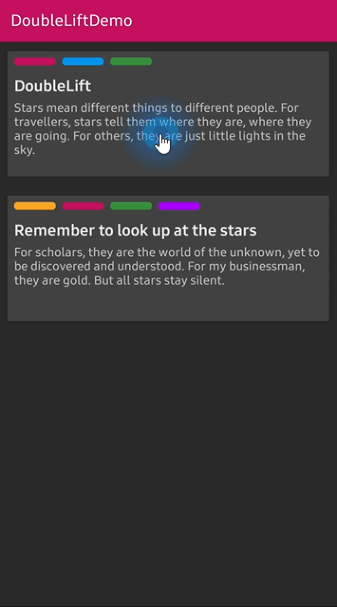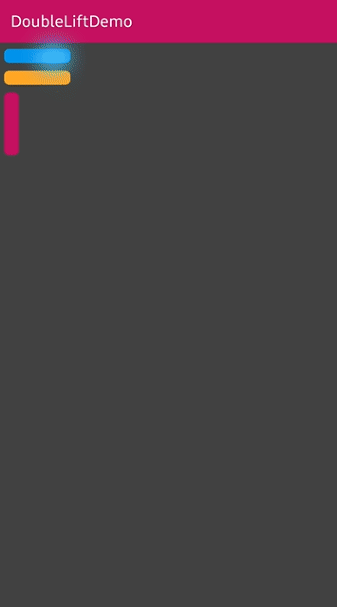Reacts dynamically with an indicator when the scroll is changed

IndicatorScrollView
Reacts dynamically with an indicator when the scroll is changed.


Including in your project
Add below codes to your root build.gradle file (not your module build.gradle file).
allprojects {
repositories {
jcenter()
}
}
And add a dependency code to your module's build.gradle file.
dependencies {
implementation "com.github.skydoves:indicatorscrollview:1.0.2"
}
Usage
Add following XML namespace inside your XML layout file.
xmlns:app="http://schemas.android.com/apk/res-auto"
IndicatorScrollView & indicatorView in layout
Here is a basic example of implementing IndicatorScrollView and indicatorView.
<com.skydoves.indicatorscrollview.IndicatorScrollView
xmlns:android="http://schemas.android.com/apk/res/android"
xmlns:app="http://schemas.android.com/apk/res-auto"
android:id="@+id/indicatorScrollView"
android:layout_width="match_parent"
android:layout_height="wrap_content">
<LinearLayout
android:layout_width="match_parent"
android:layout_height="wrap_content"
android:orientation="horizontal">
<com.skydoves.indicatorscrollview.IndicatorView
android:id="@+id/indicatorView"
android:layout_width="60dp"
android:layout_height="match_parent"
android:background="@color/background800"
android:paddingLeft="6dp"
android:paddingRight="6dp"
app:indicator_expandingRatio="0.2" // expands when an indicator item reaches the display's height ratio.
app:indicator_expandingAllItemRatio="0.9" // expands all items when scroll reaches a specific position ratio.
app:indicator_itemPadding="6dp" // padding size between indicator items.
/>
<LinearLayout
android:layout_width="match_parent"
android:layout_height="match_parent"
android:orientation="vertical"
android:paddingBottom="40dp">
// some complicated views..
<LinearLayout // This layout will be used for composing indicator.
android:id="@+id/section1"
android:layout_width="match_parent"
android:layout_height="wrap_content"/>
<LinearLayout // This layout will be used for composing indicator.
android:id="@+id/section2"
android:layout_width="match_parent"
android:layout_height="wrap_content"
</LinearLayout/>
</LinearLayout>
</com.skydoves.indicatorscrollview.IndicatorScrollView>
IndicatorScrollView
IndicatorScrollView is a scrollView for reacting with IndicatorView when scroll is changed.
It extends NestedScrollView. So it must have a ViewGroup child like what LinearLayout or RelativeLayout.
IndicatorView
IndicatorView is an indicator view for reacting to IndicatorScrollView when the scroll is changed.
It should be used in IndicatorScrollView.
Create using builder class
We can create an instance of the IndicatorView using IndicatorView.Builder class.
val indicatorView = IndicatorView.Builder(this)
.setIndicatorItemPadding(16)
.setExpandingRatio(0.2f)
.setExpandingAllItemRatio(1.0f)
.build()
Binding
We should bind an IndicatorView to IndicatorScrollView like bellow.
indicatorScrollView.bindIndicatorView(indicatorView)
IndicatorItem
IndicatorItem is an attribute item data for composing the IndicatorView.
We can create an instance of the IndicatorItem using the IndicatorItem.Builder class.
val myIndicatorItem =
IndicatorItem.Builder(section1) // section1 is the target view for the start of expanding.
.setItemColor(myColor) // sets the background color of the indicator item using value.
.setItemColorResource(R.color.colorPrimary) // sets the background color of the item using resource.
.setItemIcon(myIcon) // sets the icon of the indicator item using drawable.
.setItemIconResource(R.drawable.ic_heart) // sets the icon of the indicator item using resource.
.setItemDuration(400) // sets the expanding and collapsing duration.
.setItemCornerRadius(40f) // sets the corner radius of the indicator item.
.setItemIconTopPadding(12) // sets the padding top value between the indicator items.
.setExpandedSize(600) // customizes the fully expanded height size.
.build()
We can create it using kotlin dsl.
val myIndicatorItem = indicatorItem(section1) {
setItemColor(myColor) // sets the background color of the indicator item using value.
setItemColorResource(R.color.colorPrimary) // sets the background color of the item using resource.
setItemIcon(myIcon) // sets the icon of the indicator item using drawable.
setItemIconResource(R.drawable.ic_heart) // sets the icon of the indicator item using resource.
setItemDuration(400) // sets the expanding and collapsing duration.
setItemCornerRadius(40f) // sets the corner radius of the indicator item.
setItemIconTopPadding(12) // sets the padding top value between the indicator items.
setExpandedSize(600) // customizes the fully expanded height size.
}
And add the instance of the IndicatorItem to IndicatorView.
indicatorView.addIndicatorItem(myIndicatorItem)
// or we can use plus operator.
indicatorView + myIndicatorItem
IndicatorAnimation
We can customize the expanding and collapsing animation.
IndicatorAnimation.NORMAL
IndicatorAnimation.Accelerator
IndicatorAnimation.Bounce
| NORMAL | Accelerator | Bounce |
|---|---|---|
IndicatorView Attributes
| Attributes | Type | Default | Description |
|---|---|---|---|
| expandingRatio | Float | 0.2 | expands when an indicator item reaches the display's height ratio. |
| expandingAllItemRatio | Float | 0.9 | expands all items when scroll reaches a specific position ratio. |
| itemPadding | Dimension | 6dp | padding size between indicator items. |